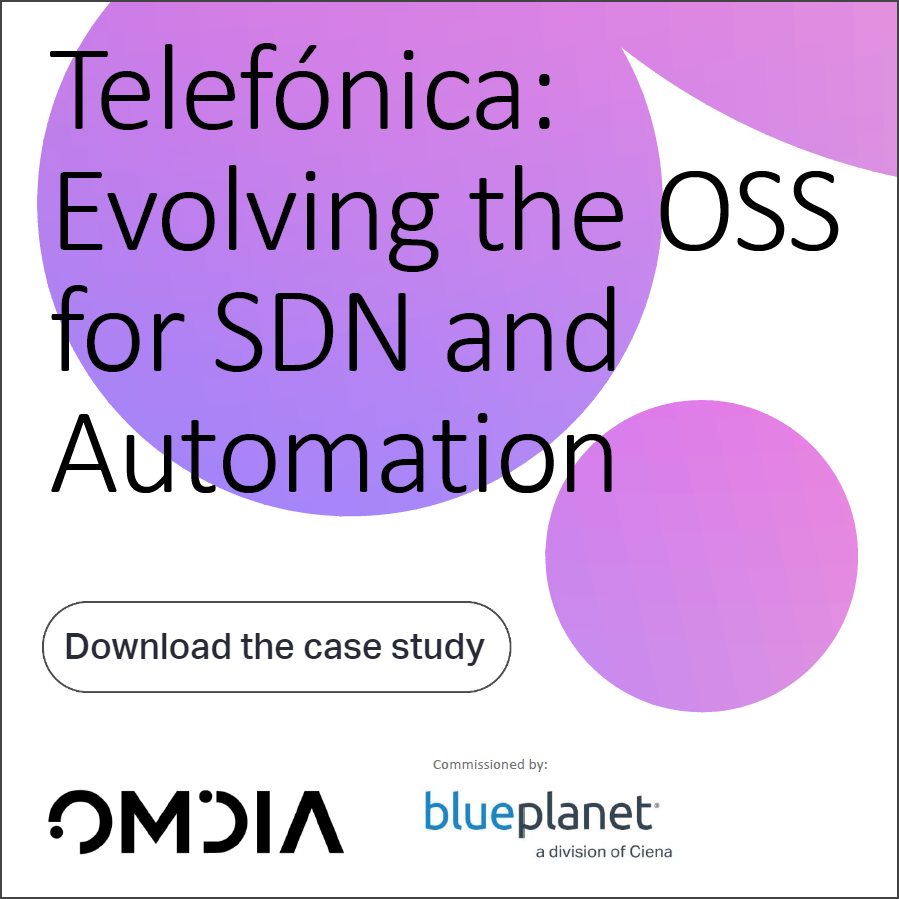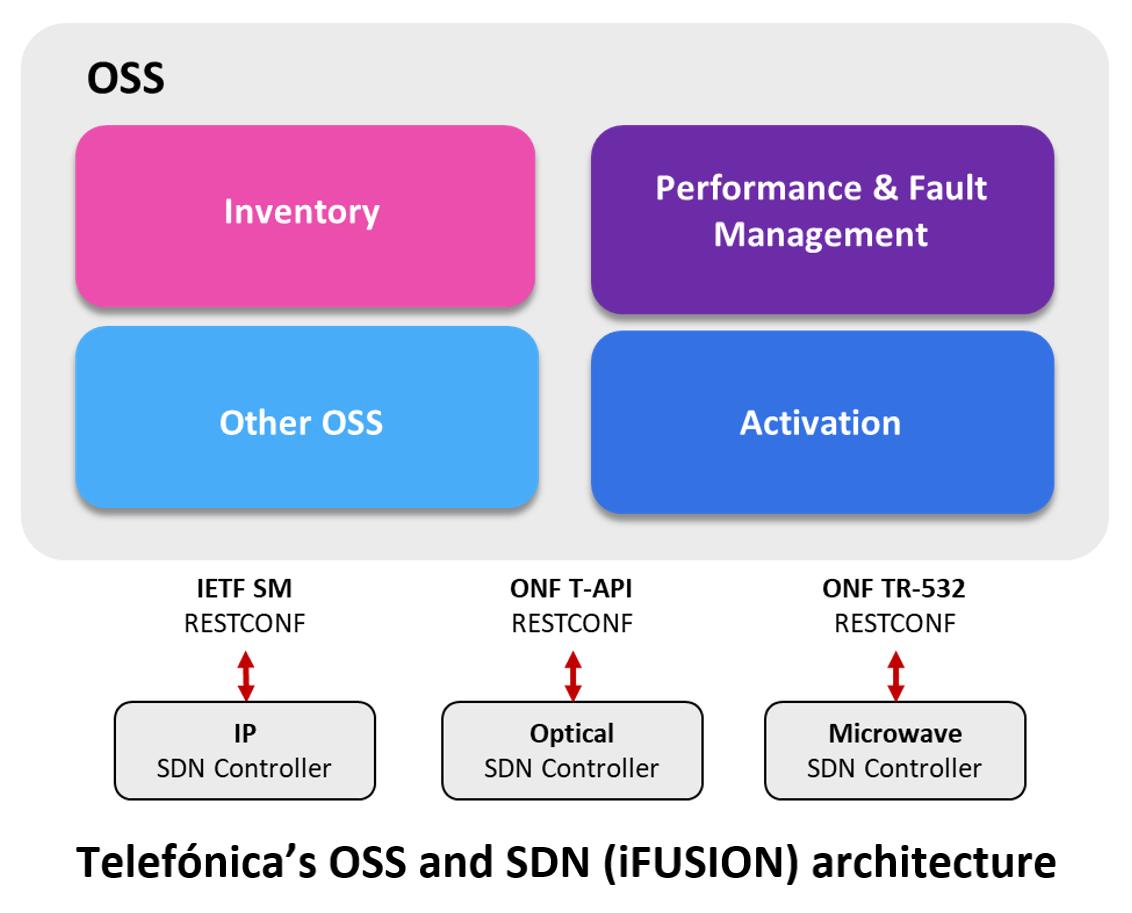How Telefónica is evolving its OSS to support network automation
Omdia's James Crawshaw details how Telefonica is working to apply SDN and automation capabilities across its network and OSS, and the results of several use cases that were successfully tested.
 James Crawshaw is Principal Analyst for Telco IT & Operations at Omdia, where he specializes in managed services and operations support systems. These include service and network management systems such as service assurance, orchestration/fulfillment, order management, inventory management, SON, network security, etc.
James Crawshaw is Principal Analyst for Telco IT & Operations at Omdia, where he specializes in managed services and operations support systems. These include service and network management systems such as service assurance, orchestration/fulfillment, order management, inventory management, SON, network security, etc.
For several years, forward-looking operators have been modernizing their transport networks using the principles of software-defined networking (SDN). Centralizing the control of network elements simplifies operations and makes the network more adaptable, automated, and responsive to new service requirements. Telefónica’s group-wide program to apply SDN across its transport networks, dubbed iFUSION, was launched in 2019.
Operators are now looking to extend this automation further up the stack, into the operations support system (OSS) domain. In Telefónica’s case the first step is the implementation of a common OSS (inventory, activation, performance management, fault management, etc.) across all its transport domains (including optical, microwave, and IP). Between this consistent OSS and the SDN controllers for the underlying transport network, Telefónica is using standard interfaces and data models from organizations like IETF and ONF.
Telefónica engaged Blue Planet in a proof of concept (POC) of two use cases—end-to-end topology discovery and transport design and provisioning—within its German subsidiary, Telefónica Deutschland. The OSS functions encompassed planning and inventory (including discovery and resource catalog), and orchestration and activation (including service catalog, service order management, and service activation).
While inventory systems are key to network operations, they often contain outdated information. Overcoming this issue requires an automated solution that can discover the inventory of active (i.e., electronic) infrastructure and how it interconnects (i.e., the topology). The first use case performed multi-layer topology and inventory discovery, with the inventory system exposing all the available services and resources to other OSS via standard interfaces from IETF and TM Forum.
The POC demonstrated that a single “source of truth” could be generated for the transport network across IP, optical and microwave domains through the implementation of the standard interfaces defined in iFUSION.
This federated inventory view avoids “swivel-chair operations” where personnel have to switch between multiple fragmented systems to piece together the overall network topology, and enables the automation of key design, planning, and service assurance processes.
 Network planners typically work with tools and databases that are separate from the inventory system, prepare documentation offline, and then implement the changes using the different element management systems (EMS). This disjointed process often introduces manual errors. The aim of the second POC use case was to fully automate the design and assign process. Given two end points, the inventory system was able to find an available path, allocate VLANs, and assign IP addresses, all based on Telefónica-defined business logic. Three examples of this use case were explored: multi-layer service design and provisioning, VPN provisioning, and label-switched path (LSP) provisioning.
Network planners typically work with tools and databases that are separate from the inventory system, prepare documentation offline, and then implement the changes using the different element management systems (EMS). This disjointed process often introduces manual errors. The aim of the second POC use case was to fully automate the design and assign process. Given two end points, the inventory system was able to find an available path, allocate VLANs, and assign IP addresses, all based on Telefónica-defined business logic. Three examples of this use case were explored: multi-layer service design and provisioning, VPN provisioning, and label-switched path (LSP) provisioning.
For each use case example, the POC showed that service activation across multi-domain, multi-vendor and multi-layered networks could be reduced from hours to minutes. In the third example, traffic engineering an LSP, activation was intent-based. Instead of sending a full design, a service intent (e.g., connect nodes A and B) was passed to the orchestrator. The orchestrator then designed, validated, and activated an LSP via the underlying SDN controller.
A key takeaway from the POC is that inventory system accuracy is critical for service planning and activation, and for reducing order fallout. The POC also demonstrated that the use of standard APIs, from the IETF, ONF, OpenConfig, and TM Forum, significantly reduced the time and cost of integrating new systems and introducing new services.
However, Telefónica found that implementation of these standard models across the vendor community is still evolving. For example, the POC found cases where the YANG models included vendor-specific attributes that required modifications to the orchestration workflows. Note, the mandatory use case requirements for SDN for Transport (MUST) workstream within the Telecom Infra Project (in which Telefónica is actively involved) includes an operator-led initiative to accelerate standard model adoption across the industry.
Operators that are looking to streamline their transport network operations and prepare for new use cases such as dynamic network slicing should ensure their inventory and activation systems are sufficiently automated. Applying SDN to the network domain brought the benefits of programmability, centralized control, and openness. This now needs to be extended upwards into the OSS domain to eliminate manual processes and enable rapid activation.
To learn more please refer to the case study, Telefónica: Evolving the OSS for SDN and Automation

